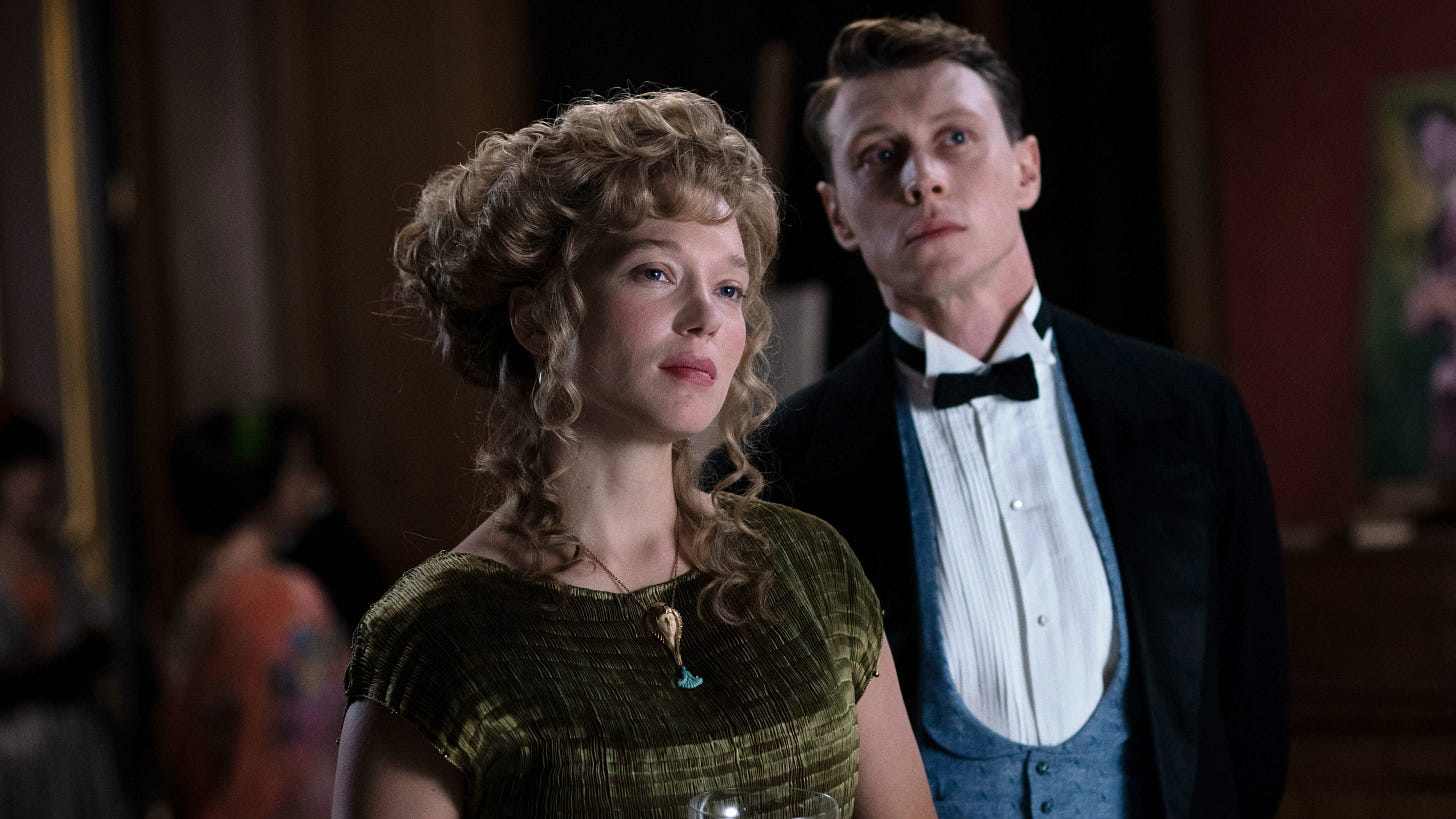La Bête (The Beast)
Kooky and languidly paced, this French/Canadian mind-bender stars Léa Seydoux and George MacKay as a couple who keep repeating their star-crossed romance across multiple lives.
I thought at first “La Bête” was based on the Beauty and the Beast legend, which has been adapted to screen many times including by French filmmaker Jean Cocteau in 1946. Or possibly a variation on another French flick sharing the same title, the 1975 erotic horror that (in)famously features explicit sex between a woman and the werewolf-like creature chasing her.
Its origins are actually more staid, the 1903 novella “The Beast in the Jungle” by Henry James (“The Portrait of a Lady”), a highfalutin rumination on fate, death and romance. (Unread by me.)
Director Bertrand Bonello (“Saint Laurent”), who co-wrote the screenplay with Guillaume Bréaud and Benjamin Charbit, has given us a very loose adaptation that follows a couple who keep repeating their star-crossed romance across multiple lives and timelines. At nearly 2½ hours long, it’s a languid and kooky affair that blends science fiction, melodrama and romantic tragedy.
It still has its moments, particularly in the more briskly paced second half, and Bonello presents some vivid and compelling scenes that will linger in the heart if not the brain.
French star Léa Seydoux (“Blue Is the Warmest Colour”) and British actor George MacKay (“1917”) play the couple, who take on various roles in the three different time zones in which we encounter them: 1910, 2014 and 2044. The idea is that they’re being reborn again and again, not just the same soul but the same person — even the same appearance.
I’ll leave it to you to quibble with the metaphysics of how this works, especially since in each iteration they are always about 30 years old and thus in 2044 they could theoretically bump into their older selves. (I guess also technically possible in 2014, though rather unlikely.)
The different time shifts are not presented in sequence, as the storyline jumps back and forth, though I didn’t have trouble following along. The 2044 timeline acts more or less as the framing device, because in this future people can undergo a “DNA purification” that rids them of any memory of their past lives.
This mainly seems to involve taking a bath in a vat of icky black goo while a robot attempts to shove a needle in your ear. Gabrielle, as Seydoux’s character always seems to go by, keeps hesitating at going through with the procedure and the rest of the movie acts as her (possibly unreliable) flashbacks to earlier lives.
In the 1910 version, Gabrielle and Bertrand, as MacKay is then known, play young aristocratic types who flirt at a fancy ball. She is a famous pianist, and they met some years earlier when they were younger. She is married to a man who owns a doll factory, but is clearly drawn to this dashing young fellow.
In 2014, things take on a decidedly more sinister note. Gabrielle is now a budding actress/model recently arrived in Los Angeles who has taken a gig as a house-sitter for some unseen wealthy dude. Bertrand is now known as Louie Lewansky, a very chilling chap who makes videos about how unfair it is that he’s never had sex or even kissed a girl, and begins stalking Gabrielle as potential payback for his incel rage.
(I find this very unlikely for a rich boy who looks like George MacKay, but we’ll go with it.)
In 2044, they are both people considering the memory-wiping procedure and meet at the purification center. In this timeline, artificial intelligence has displaced most people from their careers, with 67% unemployment and a reference to a recent civil war. It’s a vaguely post-punk era of disaffection and alienation.
A few things are the same across all timelines. Gabrielle has been haunted by a lifelong dream of doom, the sense that something terrible is certain to happen to her. She seeks out a clairvoyant for advice — a fortune teller in 1910, an internet psychic in the later versions.
The arrival of a pigeon seems to herald something impending that will be very, very bad… though I won’t spoil what it is.
In the futuristic setting, Gabrielle is assigned a “doll” guide — Kelly (Guslagie Malanda), who appears to be a lifelike AI woman who even begins to make passes at her charge. Roy Orbison’s song “Evergreen” is also heard repeatedly in the 21st century times, explicitly underscoring the theme of being trapped in time.
On some level, this movie is really deeply silly. In addition to ping-ponging back and forth between the times, it also shifts rapidly between French and English, even within the same conversation. I’m no linguist but to my ear MacKay’s French is more accomplished than Seydoux’s English.
I was pretty bored during the first hour of this movie, and even began to titter at some of its more ridiculous premises and scenarios. But it takes on more weight and an increasingly somber note as things go on, and we begin to feel empathy for these lovers who can never seem to consummate their passion. “He only makes love in his dreams,” is the soothsayer’s warning.
It’s a beastly conundrum in which they are trapped, forever fated to fall in love, if not always treating each other with kindness. It’s a scary idea for a film, not always well-executed, but interesting and occasionally compelling.





